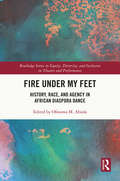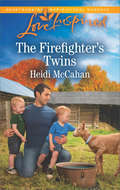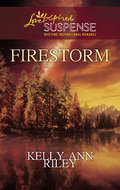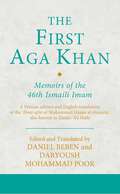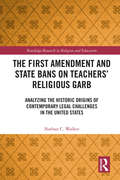- Table View
- List View
The Fire, the Star and the Cross: Minority Religions in Medieval and Early Modern Iran
by Aptin KhanbaghiAlthough today the region is mostly identified with Islam, it has been home to many other great cultures, and the civilization of the Islamic world is itself indebted to the various peoples that the Arabs subdued in the 7th and 8th centuries. Far from fading away after the Arab conquest, the inhabitants of the Iranian plateau and of Mesopotamia were central players in the lives of their regions. However, the magnitude of their contribution to the emergence of the early Islamic world has hitherto been neglected. In this fascinating and groundbreaking study, Khanbaghi offers a comprehensive discussion of those groups that resisted assimilation to the new Islamic order yet continued to participate actively in the socio-political life of their homeland. He concentrates on Iran, which due to its complex religious history offers unique opportunities for the study of non-Muslim communities, specifically of Zoroastrians, Jews and Christians.Aptin Khanbaghi has written an important and fascinating book which aims to present a thorough evaluation of the historical contributions made by religious minorities - Zoroastrians, Jews and Christians - to the societal and cultural physiognomy of the lands of Iran in pre-modern and early modern times.His general perspective and his broad treatment of the topic are quite new, while his use of sources and of the secondary literature is genuinely impressive. The Fire, the Star and the Cross makes a very significant and original contribution to our knowledge and understanding of Iranian history and civilization during an era when the foundations were laid for the emerging modern Iranian state.'BERT G FRAGNER, Director of the Institute of Iranian Studies, Austrian Academy of Sciences, Vienna
The Fire, the Star and the Cross: Minority Religions in Medieval and Early Modern Iran (International Library of Iranian Studies #5)
by Aptin KhanbaghiContemporary political events have generated a strong interest in minorities in the Middle East. Although today the region is mostly identified with Islam, it has been home to many other great cultures, and the civilization of the Islamic world is itself indebted to the various peoples that the Arabs subdued in the 7th and 8th centuries. Far from fading away after the Arab conquest, the inhabitants of the Iranian plateau and of Mesopotamia were central players in the lives of their regions. However, the magnitude of their contribution to the emergence of the early Islamic world has hitherto been neglected. In this fascinating and groundbreaking study, Khanbaghi offers a comprehensive discussion of those groups that resisted assimilation to the new Islamic order yet continued to participate actively in the socio-political life of their homeland. He concentrates on Iran, which due to its complex religious history offers unique opportunities for the study of non-Muslim communities, specifically of Zoroastrians, Jews and Christians.Aptin Khanbaghi has written an important and fascinating book which aims to present a thorough evaluation of the historical contributions made by religious minorities – Zoroastrians, Jews and Christians – to the societal and cultural physiognomy of the lands of Iran in pre-modern and early modern times. His general perspective and his broad treatment of the topic are quite new, while his use of sources and of the secondary literature is genuinely impressive. The Fire, the Star and the Cross makes a very significant and original contribution to our knowledge and understanding of Iranian history and civilization during an era when the foundations were laid for the emerging modern Iranian state.'BERT G FRAGNER, Director of the Institute of Iranian Studies, Austrian Academy of Sciences, Vienna
Fire Under My Feet: History, Race, and Agency in African Diaspora Dance (Routledge Series in Equity, Diversity, and Inclusion in Theatre and Performance)
by Ofosuwa M. AbiolaFire Under My Feet seeks to expose the diverse, significant, and often under-researched historical and developmental phenomena revealed by studies in the dance systems of the African Diaspora. In the book, written documentation and diverse methodologies are buttressed by the experiences of those whose lives are built around the practice of African diaspora dance. Replete with original perspectives, this book makes a significant contribution to dance and African diaspora scholarship simultaneously. Most important, it highlights the work of researchers from Ecuador, India, Puerto Rico, the United States, and the United Kingdom, and it exposes under-researched and omitted voices of the African diaspora dance world of the aforesaid locations and Puerto Rico, Columbia, and Trinidad as well. This study showcases a blend of scholars, dance practitioners, and interdisciplinarity, and engages the relationship between African diaspora dance and the fields of history, performance studies, critical race theory, religion, identity, and black agency.
Fire Under My Feet: History, Race, and Agency in African Diaspora Dance (Routledge Series in Equity, Diversity, and Inclusion in Theatre and Performance)
by Ofosuwa M. AbiolaFire Under My Feet seeks to expose the diverse, significant, and often under-researched historical and developmental phenomena revealed by studies in the dance systems of the African Diaspora. In the book, written documentation and diverse methodologies are buttressed by the experiences of those whose lives are built around the practice of African diaspora dance. Replete with original perspectives, this book makes a significant contribution to dance and African diaspora scholarship simultaneously. Most important, it highlights the work of researchers from Ecuador, India, Puerto Rico, the United States, and the United Kingdom, and it exposes under-researched and omitted voices of the African diaspora dance world of the aforesaid locations and Puerto Rico, Columbia, and Trinidad as well. This study showcases a blend of scholars, dance practitioners, and interdisciplinarity, and engages the relationship between African diaspora dance and the fields of history, performance studies, critical race theory, religion, identity, and black agency.
Fire under the Ashes: An Atlantic History of the English Revolution
by John DonoghueIn Fire under the Ashes, John Donoghue recovers the lasting significance of the radical ideas of the English Revolution, exploring their wider Atlantic history through a case study of Coleman Street Ward, London. Located in the crowded center of seventeenth-century London, Coleman Street Ward was a hotbed of political, social, and religious unrest. There among diverse and contentious groups of puritans a tumultuous republican underground evolved as the political means to a more perfect Protestant Reformation. But while Coleman Street has long been recognized as a crucial location of the English Revolution, its importance to events across the Atlantic has yet to be explored. Prominent merchant revolutionaries from Coleman Street led England’s imperial expansion by investing deeply in the slave trade and projects of colonial conquest. Opposing them were other Coleman Street puritans, who having crossed and re-crossed the ocean as colonists and revolutionaries, circulated new ideas about the liberty of body and soul that they defined against England’s emergent, political economy of empire. These transatlantic radicals promoted social justice as the cornerstone of a republican liberty opposed to both political tyranny and economic slavery—and their efforts, Donoghue argues, provided the ideological foundations for the abolitionist movement that swept the Atlantic more than a century later.
Fire under the Ashes: An Atlantic History of the English Revolution
by John DonoghueIn Fire under the Ashes, John Donoghue recovers the lasting significance of the radical ideas of the English Revolution, exploring their wider Atlantic history through a case study of Coleman Street Ward, London. Located in the crowded center of seventeenth-century London, Coleman Street Ward was a hotbed of political, social, and religious unrest. There among diverse and contentious groups of puritans a tumultuous republican underground evolved as the political means to a more perfect Protestant Reformation. But while Coleman Street has long been recognized as a crucial location of the English Revolution, its importance to events across the Atlantic has yet to be explored. Prominent merchant revolutionaries from Coleman Street led England’s imperial expansion by investing deeply in the slave trade and projects of colonial conquest. Opposing them were other Coleman Street puritans, who having crossed and re-crossed the ocean as colonists and revolutionaries, circulated new ideas about the liberty of body and soul that they defined against England’s emergent, political economy of empire. These transatlantic radicals promoted social justice as the cornerstone of a republican liberty opposed to both political tyranny and economic slavery—and their efforts, Donoghue argues, provided the ideological foundations for the abolitionist movement that swept the Atlantic more than a century later.
Fire under the Ashes: An Atlantic History of the English Revolution
by John DonoghueIn Fire under the Ashes, John Donoghue recovers the lasting significance of the radical ideas of the English Revolution, exploring their wider Atlantic history through a case study of Coleman Street Ward, London. Located in the crowded center of seventeenth-century London, Coleman Street Ward was a hotbed of political, social, and religious unrest. There among diverse and contentious groups of puritans a tumultuous republican underground evolved as the political means to a more perfect Protestant Reformation. But while Coleman Street has long been recognized as a crucial location of the English Revolution, its importance to events across the Atlantic has yet to be explored. Prominent merchant revolutionaries from Coleman Street led England’s imperial expansion by investing deeply in the slave trade and projects of colonial conquest. Opposing them were other Coleman Street puritans, who having crossed and re-crossed the ocean as colonists and revolutionaries, circulated new ideas about the liberty of body and soul that they defined against England’s emergent, political economy of empire. These transatlantic radicals promoted social justice as the cornerstone of a republican liberty opposed to both political tyranny and economic slavery—and their efforts, Donoghue argues, provided the ideological foundations for the abolitionist movement that swept the Atlantic more than a century later.
Fire under the Ashes: An Atlantic History of the English Revolution
by John DonoghueIn Fire under the Ashes, John Donoghue recovers the lasting significance of the radical ideas of the English Revolution, exploring their wider Atlantic history through a case study of Coleman Street Ward, London. Located in the crowded center of seventeenth-century London, Coleman Street Ward was a hotbed of political, social, and religious unrest. There among diverse and contentious groups of puritans a tumultuous republican underground evolved as the political means to a more perfect Protestant Reformation. But while Coleman Street has long been recognized as a crucial location of the English Revolution, its importance to events across the Atlantic has yet to be explored. Prominent merchant revolutionaries from Coleman Street led England’s imperial expansion by investing deeply in the slave trade and projects of colonial conquest. Opposing them were other Coleman Street puritans, who having crossed and re-crossed the ocean as colonists and revolutionaries, circulated new ideas about the liberty of body and soul that they defined against England’s emergent, political economy of empire. These transatlantic radicals promoted social justice as the cornerstone of a republican liberty opposed to both political tyranny and economic slavery—and their efforts, Donoghue argues, provided the ideological foundations for the abolitionist movement that swept the Atlantic more than a century later.
The Firefighter Daddy: The Firefighter Daddy Her Small-town Romance The Nanny's Secret Child (Mills And Boon Love Inspired Ser.)
by Margaret DaleyFrom Bachelor to Father
The Firefighter's Match: Tail Of Two Hearts The Firefighter's Match Sleigh Bell Sweethearts (Gordon Falls #3)
by Allie PleiterAfter serving overseas, former soldier Josephine "J.J." Jones needs a fresh start. And Gordon Falls is just the place.
The Firefighter's New Family: Bayou Sweetheart The Firefighter's New Family Season Of Redemption (Mills And Boon Love Inspired Ser.)
by Gail Gaymer MartinLOVE TO THE RESCUE
A Firefighter's Promise: The Doctor's Second Chance Winning The Teacher's Heart A Firefighter's Promise (Mills And Boon Love Inspired Ser.)
by Patricia JohnsA Hero for Her Son
The Firefighter's Twins: Her Forgiving Amish Heart His Surprise Son The Firefighter's Twins (Mills And Boon Love Inspired Ser.)
by Heidi McCahanOne single dad + twin toddlers A formula for her new family?
Fireman Dad (Mills And Boon Love Inspired Ser.)
by Betsy St. Amant“Mommy, I Want To Be A Fireman. ”
The Fireman Finds a Wife: Her Unlikely Cowboy North Country Mom The Fireman Finds A Wife (Cedar Springs #1)
by Felicia MasonHer Unexpected Hero
The Fireman's Homecoming (Gordon Falls #2)
by Allie PleiterBlack Sheep Son Nothing about going home to Gordon Falls is easy for fireman Clark Braden. His role as local bad boy is firmly established, though he’s determined to use his newfound faith to change people’s minds. But Clark isn’t the only one coming home to hard times.
The Fireman's Secret: Daddy Wanted The Fireman's Secret Falling For Texas The Engagement Bargain (Goose Harbor #2)
by Jessica KellerRekindling Her Life
Fires of Faith: Catholic England under Mary Tudor
by Eamon DuffyThe reign of Mary Tudor has been remembered as an era of sterile repression, when a reactionary monarch launched a doomed attempt to reimpose Catholicism on an unwilling nation. Above all, the burning alive of more than 280 men and women for their religious beliefs seared the rule of “Bloody Mary” into the protestant imagination as an alien aberration in the onward and upward march of the English-speaking peoples.In this controversial reassessment, the renowned reformation historian Eamon Duffy argues that Mary's regime was neither inept nor backward looking. Led by the queen's cousin, Cardinal Reginald Pole, Mary’s church dramatically reversed the religious revolution imposed under the child king Edward VI. Inspired by the values of the European Counter-Reformation, the cardinal and the queen reinstated the papacy and launched an effective propaganda campaign through pulpit and press.Even the most notorious aspect of the regime, the burnings, proved devastatingly effective. Only the death of the childless queen and her cardinal on the same day in November 1558 brought the protestant Elizabeth to the throne, thereby changing the course of English history.
Firestorm (Mills And Boon Love Inspired Ser.)
by Kelly Ann RileyCaring for his traumatized son is widowed FBI agent Luke Tanner's number one priority. But when he becomes temporary fire chief in a small mountain town, a case sparks out of his control.
The First Aga Khan: A Persian Edition and English Translation of Hasan 'Ali Shah's Tarkha-i 'ibrat-afza (Ismaili Texts and Translations)
by Daniel Beben and Daryoush Mohammad PoorI.B. Tauris in association with the Institute of Ismaili StudiesMuhammad Hasan al-Husayni, also known as Hasan 'Ali Shah and, more generally, as the Aga Khan (1804-1881), was the 46th Imam of the Nizari Ismailis and the first Ismaili Imam to bear the title of Aga Khan, bestowed on him by the contemporary Qajar monarch of Persia. This book is the first English translation of his memoirs, the 'Ibrat-afza, `A Book of Exhortation, or Example', and includes a new edition of the Persian text and a detailed introduction to the work and its context. The 'Ibrat-afza was composed in the year 1851, following the Ismaili Imam's departure from Persia and his permanent settlement in India. The text recounts the Aga Khan's early life and political career as the governor of the province of Kirman in Persia, and narrates the dramatic events of his conflict with the Qajar establishment followed by his subsequent travels and exploits in Afghanistan and British India. The 'Ibrat-afza provides a rare example of an autobiographical account from an Ismaili Imam and a first-hand perspective on the regional politics of the age. It offers a window into the history of the Ismailis of Persia, India and Central Asia at the dawn of the modern era of their history. Consequently, the book will be of great interest to both researchers and general readers interested in Ismaili history and in the history of the Islamic world in the nineteenth century.
The First Aga Khan: A Persian Edition and English Translation of Hasan 'Ali Shah's Tarkha-i 'ibrat-afza (Ismaili Texts and Translations)
I.B. Tauris in association with the Institute of Ismaili StudiesMuhammad Hasan al-Husayni, also known as Hasan 'Ali Shah and, more generally, as the Aga Khan (1804-1881), was the 46th Imam of the Nizari Ismailis and the first Ismaili Imam to bear the title of Aga Khan, bestowed on him by the contemporary Qajar monarch of Persia. This book is the first English translation of his memoirs, the 'Ibrat-afza, `A Book of Exhortation, or Example', and includes a new edition of the Persian text and a detailed introduction to the work and its context. The 'Ibrat-afza was composed in the year 1851, following the Ismaili Imam's departure from Persia and his permanent settlement in India. The text recounts the Aga Khan's early life and political career as the governor of the province of Kirman in Persia, and narrates the dramatic events of his conflict with the Qajar establishment followed by his subsequent travels and exploits in Afghanistan and British India. The 'Ibrat-afza provides a rare example of an autobiographical account from an Ismaili Imam and a first-hand perspective on the regional politics of the age. It offers a window into the history of the Ismailis of Persia, India and Central Asia at the dawn of the modern era of their history. Consequently, the book will be of great interest to both researchers and general readers interested in Ismaili history and in the history of the Islamic world in the nineteenth century.
The First Amendment and State Bans on Teachers' Religious Garb: Analyzing the Historic Origins of Contemporary Legal Challenges in the United States (Routledge Research in Religion and Education)
by Nathan C. WalkerExamining the twelve-decade legal conflict of government bans on religious garb worn by teachers in U.S. public schools, this book provides comprehensive documentation and analysis of the historical origins and subsequent development of teachers’ religious garb in relation to contemporary legal challenges within the United Nations and the European Union. By identifying and correcting factual errors in the literature about historical bans on teachers’ garb, Walker demonstrates that there are still substantial and unresolved legal questions to the constitutionality of state garb statutes and reflects on how the contemporary conflicts are historically rooted. Showcased through a wealth of laws and case studies, this book is divided into eight clear and concise chapters and answers questions such as: what are anti-religious-garb laws?; how have the state and federal court decisions evolved?; what are the constitutional standards?; what are the establishment clause and free exercise clause arguments?; and how has this impacted current debates on teachers’ religious garb?, before concluding with an informative summary of the points discussed throughout. The First Amendment and State Bans on Teachers’ Religious Garb is the ideal resource for researchers, academics, and postgraduate students in the fields of education, religion, education policy, sociology of education, and law, or those looking to explore an in-depth development of the laws and debates surrounding teachers’ religious garb within the last 125 years.
The First Amendment and State Bans on Teachers' Religious Garb: Analyzing the Historic Origins of Contemporary Legal Challenges in the United States (Routledge Research in Religion and Education)
by Nathan C. WalkerExamining the twelve-decade legal conflict of government bans on religious garb worn by teachers in U.S. public schools, this book provides comprehensive documentation and analysis of the historical origins and subsequent development of teachers’ religious garb in relation to contemporary legal challenges within the United Nations and the European Union. By identifying and correcting factual errors in the literature about historical bans on teachers’ garb, Walker demonstrates that there are still substantial and unresolved legal questions to the constitutionality of state garb statutes and reflects on how the contemporary conflicts are historically rooted. Showcased through a wealth of laws and case studies, this book is divided into eight clear and concise chapters and answers questions such as: what are anti-religious-garb laws?; how have the state and federal court decisions evolved?; what are the constitutional standards?; what are the establishment clause and free exercise clause arguments?; and how has this impacted current debates on teachers’ religious garb?, before concluding with an informative summary of the points discussed throughout. The First Amendment and State Bans on Teachers’ Religious Garb is the ideal resource for researchers, academics, and postgraduate students in the fields of education, religion, education policy, sociology of education, and law, or those looking to explore an in-depth development of the laws and debates surrounding teachers’ religious garb within the last 125 years.
First among Friends: George Fox and the Creation of Quakerism
by H. Larry IngleIn First Among Friends, the first scholarly biography of George Fox (1624-91), H. Larry Ingle examines the fascinating life of the reformation leader and founding organizer of the Religious Society of Friends, more popularly known today as the Quakers. Ingle places Fox within the upheavals of the English Civil Wars, Revolution, and Restoration, showing him and his band of "rude" disciples challenging the status quo, particularly during the Cromwellian Interregnum. Unlike leaders of similar groups, Fox responded to the conservatism of the Stuart restoration by facing down challenges from internal dissidents, and leading his followers to persevere until the 1689 Act of Toleration. It was this same sense of perseverance that helped the Quakers to survive and remain the only religious sect of the era still existing today. This insightful study uses broad research in contemporary manuscripts and pamphlets, many never examined systematically before. Firmly grounded in primary sources and enriched with gripping detail, this well-written and original study reveals unknown sides of one who was clearly "First Among Friends."
The First and Second Books of Samuel (The Pocket Canons #14)
by Meir ShalevThis volume presents the Old Testament book of Samuel, with an introduction by Meir Shalev. In two parts, the book tells the story of one of the most charismatic of Old Testament characters, King David and his meteoric rise and inevitable fall.


